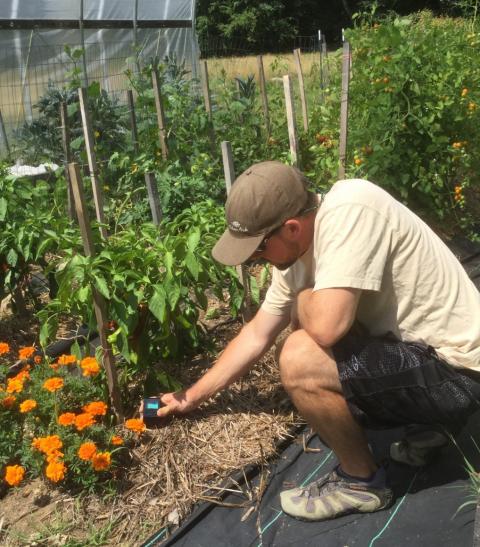Irrigation Systems for the Garden

Micro-sprinklers, drip irrigation, and soaker hoses are all low-volume and highly efficient irrigation techniques when used correctly. Plants in your garden will grow better with even soil moisture and irrigation can be a great way to not only conserve water, but also reduce stress to your plants and physiological issues like cracking and blossom end rot. Other advantages are reduced runoff when irrigating on a slope, adaptability as your garden changes and grows, and the opportunity to automate and optimize watering. These systems are also increasingly accessible and affordable for home gardeners, and many suppliers carry products specifically designed for small scale use, even as small as raised beds and containers.
There are a few ways of irrigating a garden:
- Overhead watering with a sprinkler system: oscillating or impact sprinklers
- Hand watering
- Micro sprinklers
- Drip irrigation tape
- Soaker hoses
There are also a few sources of water for irrigating the garden:
- Municipal/city water
- Well water
- Surface water like streams or ponds
- Rainwater, captured with a rain barrel.
Rain Barrels
When using a rain barrel, the rainwater is often collected from a roof. Keep in mind there may be bird excrement or substances on the roof that may impact the safety of using collected rainwater on crops you plan to eat. If you are going to use this type of water, preferably use it in a drip system and ensure the drip tape is under mulch so that the water isn't wetting the foliage of your food crops.
A typical practice is to utilize screening to prevent debris from entering the barrel, while also preventing insects such as mosquitoes from utilizing the water source as a breeding location. Some barrels come with rings that can be screwed on to the top of the barrel. These typically have a few larger holes cut out for water to enter from gutters, or whatever the surface is that will collect the water to be diverted into the barrel. Screening can be laid over the top of the barrel before the ring is screwed on to trap it in place and filter out large debris.
Irrigation Rate
If you are using water from a well, you will want to measure the output of your well. There is significant variation. To find out what your flow rate is, see how long it takes to fill a 5-gallon bucket at full pressure and then go from there to do your calculations. The math is simple. You need to convert seconds to minutes, so divide the number of seconds it took to fill the bucket by 60, and then plug that into the formula of gallons / minutes = gallons per minute. For example, if it took 10 seconds to fill your 5-gallon bucket, the equation is 5 / (10/60 = .17) = 29.4 gallons per minute. Your drip tape will list a maximum flow rate. If that maximum flow rate is .5 gallons per minute per 100 feet, which is a common maximum flow rate, then you use the formula of (gallons per minute / maximum flow rate) x 100 feet to calculate how much drip tape you can use in a zone. Each zone has its own submain pipe, and you do these calculations to ensure that you don’t exceed the capacity of your system and can control how much water goes through your system to your plants in a given time. You will only run water into one zone at a time. Learn more about these calculations from the fact sheet Simple Calculations for Small Drip Irrigation Systems from the University of Kentucky Cooperative Extension Service.
Understanding what your maximum flow rate is from your water source, what flow rate can be supported by your irrigation system, and critically how much water you need to provide for your crops, you can hone in on how long you want to run your system at a given time.
If there is elevation change, Colorado State Extension says that a general rule of thumb is to add 5 psi to the operating pressure for every 10-foot rise in elevation above the point of connection to the water source.
Your soil profile is a factor in determining how much irrigation to provide. A loamy soil with a higher organic matter content will have good water holding capacity and good drainage, whereas a clay soil will hold water with poor drainage and sandy soil will have poor water holding capacity. With sandy soil, you will want to water more frequently for short bursts, whereas a loamy soil will be better suited to less frequent, deeper watering.
A soil moisture sensor is a helpful tool to guide your irrigation rates. Regularly monitoring soil moisture levels and adjusting the frequency and volume of your irrigation makes a significant difference, and should be done throughout the growing season as your crops develop and weather changes. Generally, crops need more frequent watering when they are less developed, and less frequent, deeper watering as they are further developed. In a garden setting, a moisture meter will likely show your levels on a dry to moist scale and come with a guide to where you want moisture levels to be for different crops.
An alternative or supplement to a moisture meter can be the use of a rain gauge or rainfall monitoring data from a source like NEWA.
Water Quality
If you utilize a water softener, you will need to install a hose spigot before the water reaches the softener so you can divert that water to your garden and landscape before it goes through the water softener. The sodium-based salts used by water softeners are toxic to plants, so you should never water plants with softened water.
Filtration to remove algae, sand and other materials is important. If using surface water or well water, you may need to use more elaborate filters, and frequent cleaning may be necessary if you are not using self-cleaning emitters. Filters with a higher mesh count have greater screening capacity. Look for Y or T filters that do not require dismantling to clean, as opposed to in-line filters.
Drip Irrigation
The basic components of a drip irrigation system are as follows:
- The distribution system, consisting of the hose bibb, filter assembly and feeder lines - we recommend a backflow prevention device and a pressure reducing valve, and a timer can also be incorporated between the hose bibb and the filter body.
- The feeder lines, with drip tape attached to quarter turn valves
- The drip tape, folded over several times at the end
Drip tape is an efficient way of irrigating your plants that enables a high degree of control over how much you are irrigating your crops and how it is spaced to provide optimal irrigation for your garden's design. Drip tape is most suitable for annual crops being grown in rows.
It is important to properly space emitters. If placed poorly or too far apart, plants can suffer. Another mistake to avoid is using more than 200 feet of mainline for a single zone.
If you are just using drip tape for irrigation, you should be able to get several seasons out of the tape if stored properly over winter. If you are feeding fertilizer through the tape, it may only last a season. If your tape has suffered damage or clogging, it may be worthwhile to replace the tape instead of trying to get another season out of it.
Drip tubing is another technique for drip irrigation. Tubing is more rugged and can be left in the ground over the winter, so is better suited to perennial plantings such as perennial vegetables, fruits, trees, and shrubs. The tubing needs to be drained of water at the end of fall but can be left over winter.
If you are gardening in raised beds, some additional plumbing is necessary with a few more fittings to create the necessary angles.
For maintenance, you should regularly monitor for leaks. If you have a timer with a flow meter, you will notice a spike in flow that might signal a leak. Another way you might notice a leak is if plants in an area start to struggle (curled leaves, off colors in the leaves, etc.). In that case, the irrigation system should be checked in that area for clogs or leaks. Nuisance wildlife can be an issue, so look for chewing on lines and respond accordingly with needed repairs and wildlife management as needed. Goof plugs can be used to plug holes in the mainline that are not needed.
When you harvest crops, we recommend turning off water flow to that area.
Store your feeder lines with vales open and one end cap removed. Ensure all water has drained out and attach the lines to a wall or fence with the opened end at the lowest point. Ensure that you remove your filter assembly from the hose bibb and feeder lines as well. In the spring, check for leaks and cracks with closing all your valves and pressurizing the system.
Other Systems
Soaker hoses are perforated rubber hoses with either small holes that slowly release water into the soil or that exude water along the entire length of the hose. Soaker hoses can be placed in a curved orientation and then be buried in mulch, proving optimum irrigation hidden from sight. Soaker hoses are well suited to plantings in irregular shapes and can also be a good option for raised beds. Soaker hoses are a great entry level option for a gardener that wants to move away from overhead irrigation.
We will caution that soaker hoses can get plugged up and suffer from declining flow as the hose gets filled up with bacterial iron, calcium deposits, sand, and other debris. Moisture levels should be regularly monitored to ensure the soaker hose is working properly, and the hoses themselves should also be regularly inspected to ensure they are emitting water as intended.
Micro-sprinklers, which are also called micro-sprayers, can be a good option for certain crops, and are an excellent option for raised beds. These systems will provide excellent coverage and come in a variety of sizes and patterns to meet your needs. Micro-sprinklers may be a great option for leafy greens in particular.
Upgrading your sprinkler is another great option. Oscillating sprinklers that are sturdy, adjustable, and made with quality materials can make a significant difference. For overhead irrigation, limit your watering to the early morning rather than during the day or in the evening.
Sources and additional reading:
Building and Operating a Home Irrigation System: Penn State
Go with the Flow Simple Calculations for Small Drip Irrigation Systems: Kentucky
Drip Irrigation for Home Gardens: Colorado State
Jeremy DeLisle on Granite State Gardening
Jeremy DeLisle joined Granite State Gardening on August 20 to talk about irrigation systems for New Hampshire gardens. You can watch the full interview below. This article summarizes and expands upon key topics covered in the interview.
Got questions? The Ask UNH Extension Infoline offers practical help finding answers for your home, yard, and garden questions. Call toll free at 1-877-398-4769, Monday to Friday, 9 a.m. to 2 p.m., or e-mail us at answers@unh.edu.

